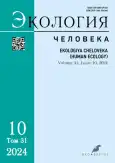卷 31, 编号 10 (2024)
- 年: 2024
- ##issue.datePublished##: 13.06.2025
- 文章: 6
- URL: https://hum-ecol.ru/1728-0869/issue/view/11498
ORIGINAL STUDY ARTICLES
慢性照射女性外周血T淋巴细胞中X染色体畸变的远期观察:一项初步研究
摘要
背景。由于居住在放射性核素污染地区而导致的慢性辐射暴露,是当今社会面临的重要问题之一。电离辐射会显著增加白血病、实体性恶性肿瘤及其他疾病的发生风险。当前研究认为,多种人类疾病与体细胞嵌合性突变密切相关,尤其是涉及性染色体的突变。X染色体在免疫系统功能和自身免疫过程的调控中发挥关键作用,其非整倍体现象被认为与多种躯体疾病相关。此前针对Southern Ural地区受照人群的细胞遗传效应研究显示,X染色体在微核形成中参与比例较高,因此本研究决定进一步深入分析X染色体的畸变情况。
目的。评估慢性辐射暴露女性在远期观察中外周血T淋巴细胞中X染色体的染色体内与染色体间畸变情况。
材料与方法。本初步研究纳入5名曾在南乌拉尔地区长期接受慢性辐射暴露的女性,平均年龄为74.0±0.8岁,红骨髓平均累积剂量为1.35±0.30 Gy。对照组包括5名女性,平均年龄为66.3±1.2岁,红骨髓平均累积剂量为0.010±0.006 Gy(范围0–0.03 Gy)。 对照组为居住在社会经济条件相似地区的女性,其整个观察期间红骨髓的累积受照剂量不超过70 mGy。采用多色带染色(mBAND)技术分析X染色体相关的染色体畸变,畸变频率按基因组当量计算,分析中考虑供体年龄因素。同时还评估了X染色体非整倍体细胞的频率。
结果。受照女性X染色体畸变频率显著高于对照组(0.100±0.036 vs 0.019±0.011,U=3, p=0.0476)。此外,受照组的畸变类型更为多样,观察到环状染色体、等臂染色体及可能由染色体粉碎形成的异常结构。受照女性的X染色体非整倍体细胞平均频率与对照组相比无统计学显著差异(p=0.4),但可能存在个体间差异。
结论。研究结果提示,在慢性辐射暴露下,受照人群可能经历更为活跃的突变过程。针对在Southern Ural地区长期接受辐射暴露女性外周血T淋巴细胞中X染色体畸变的研究具有前景,有必要继续深入开展相关研究。
 709-720
709-720


候选基因多态性与振动病的关联性分析
摘要
背景。鉴定与职业病发生密切相关的分子遗传标志物,有助于制定及时有效的预防措施。目前,振动病的分子遗传学机制尚未得到充分研究。
目的。探讨SOD2、TNF-α、IL-1β、MMP-1和IL-6基因多态性与振动病之间的关联。
材料与方法。本研究为一项“病例–对照”类型的单时点研究,共纳入71名经诊断为振动病的患者。所有病例组患者均为2022–2023年间在Ufa Research Institute of Occupational Medicine and Human Ecology附属诊所接受检查和治疗的对象,通过全纳方式纳入研究。对照组为76名在职业活动中未接触振动因素的个体。基因多态性检测采用实时荧光定量聚合酶链式反应(qPCR)方法,使用特异性寡核苷酸引物和位点特异性标记寡核苷酸探针进行。
结果。研究发现,SOD2基因rs4880多态位点与振动病的发生存在显著关联:T等位基因是发病的风险因素,而C等位基因具有保护作用。TNF-α基因rs361525、IL-1β基因rs16944、 MMP-1基因rs1799750和IL-6基因rs1800795多态位点在病例组与对照组的基因型及等位基因频率分布中未发现统计学显著差异。
结论。SOD2基因rs4880多态性与振动病的发生具有显著相关性。而TNF-α、IL-1β、MMP-1和IL-6基因多态性与振动病之间未见明显关联。本研究结果可作为制定针对振动病高风险人群的筛查方案的依据。
 721-729
721-729


在欧洲北部条件下季节性因素对青少年心率与心电图TP段指标的影响研究
摘要
背景。居住在欧洲北部强大陆性气候条件下的人群,为适应显著的季节性气温变化及其他气象因素,形成了特有的生理适应机制。分析心脏对这些季节变化的个体反应,对于理解极端气候条件下的生存与适应策略具有重要意义。
目的。基于心率与TP段持续时间的参数,探讨居住在Syktyvkar市的15–16岁青少年在1月与5月期间心脏时频特征之间的关系。
材料与方法。对22名15–16岁青少年在站立位和接受体位变换试验(从站立转为卧位)期间,于1月和5月分别记录 II 导联心电图。基于20个心动周期的记录计算心率和TP段持续时间。数据统计处理采用Excel软件。
结果。对心率和TP段持续时间的群体平均值分析未发现统计学意义上的季节差异。然而,个体数据的深入分析显示,心率和TP段持续时间均存在明显的季节性波动。在冬季,心率对体位变换试验的反应更为显著,最大变化幅度达39%,而5月为23%。TP段持续时间的变化趋势亦类似。个体化分析显示,多数受试者在不同季节表现出心率和TP段的不同程度变化。
结论。结果表明,在评估季节性环境影响时,需采用个体化评估方法。
 730-737
730-737


光照去同步模型下实验大鼠体能的季节性变化及其对体力活动的适应过程
摘要
论证。过去五年中,基于动物实验与流行病学观察的研究进一步证实了光照去同步对机体具有不利影响。生物节律结构的紊乱不可避免地导致体内稳态失衡和适应能力下降,进而可能诱发病理过程。
目的。探讨在光照去同步模型条件下实验大鼠体能的季节性动态及其对体力负荷的适应过程,并评估该条件下血清乳酸水平的变化情况。
材料与方法。实验在秋冬与春夏两季进行,研究对象为240只性成熟的Wistar雄性大鼠。通过将实验动物连续10天置于全天候强光(150 lx)或完全黑暗(2–3 lx)环境中,构建光照去同步模型。为研究体能的季节性变化,采用强迫游泳至完全疲劳的方法,在每天相同时间连续五天各进行一次测试。血清乳酸浓度使用标准试剂盒法测定。
结果。结果显示,大鼠体能水平与血清乳酸浓度存在显著相关性:体能越高,乳酸水平越低。同时,光照去同步联合游泳测试对乳酸水平的变化具有一定的特异性影响。
结论。在光照去同步条件下,实验大鼠体能的季节性节律及其血清乳酸含量的变化反映出机体适应-代偿机制处于紧张状态,并提示存在代谢失调的可能。
 738-749
738-749


地磁场变化与人体心律参数之间的同步效应:植物神经系统的潜在作用
摘要
背景。地磁场变化是一种重要的生态因素,对人体健康和功能状态,尤其是心血管系统具有显著影响。然而,其生物物理作用机制以及在不同时间和空间尺度上的现象表现尚不明确。本文延续了我们此前关于人体静息状态下心律波动与毫赫兹频段地磁场变化(周期为3–40分钟)之间同步现象(即“生物-地磁同步效应”)的研究。
目的。评估植物神经系统作为人体对地磁场变化反应中介环节的可能作用。
材料与方法。2012年至2024年期间,共进行了673次静息状态下的心率间期图记录实验。第一组为8名基本健康志愿者,每人进行多次记录(每次100–120分钟);第二组为39人,仅记录一次(时长60分钟)。比较两组受试者逐分钟的心率与心率变异性时间序列中生物-地磁同步效应的发生频率。分析方法包括交叉相关分析与小波分析。
结果。在全部实验样本中,采用相关分析法,心率参数与地磁场矢量分量的同步出现率为32%,而心率变异性指标的同步率为9–17%,差异达两倍以上。根据小波谱相似性标准,心率同步效应的发生率为40%,心率变异性参数为24–28%。第一组每位志愿者及第二组整体的结果分布基本一致。
结论。在个体多次观测结果与志愿者群体分析中均可见,与心率变异性参数相比,心率指标的动态变化更频繁且在统计学上显著地(p < 0.001)呈现出生物-地磁同步效应。
 750-767
750-767


农村青少年膳食中饱和与不饱和脂肪酸含量:与脂质过氧化过程的相关性
摘要
背景。均衡膳食是心血管疾病预防的关键因素之一。青少年膳食中充足的脂肪酸摄入,无疑是其抵御不良环境因素的一个重要条件。脂质过氧化反应与抗氧化防御反应的活性,有助于评估个体对不利因素的抵抗能力,并决定其适应性反应。生活在农村地区的青少年尚未被充分研究。
目的。明确农村青少年膳食中脂肪酸组成的特征,评估其“脂质过氧化–抗氧化防御”系统的相关指标,并分析二者之间的可能关联。
材料与方法。采用横断面研究方法,分析了Irkutsk州农村地区76名14–17岁青少年(38名男生、38名女生)的数据。通过24小时膳食回顾法评估实际摄入,并将其与能量和营养素生理需求标准进行对比。“脂质过氧化–抗氧化防御”系统指标通过分光光度法和荧光光度法测定。
结果。农村青少年膳食中饱和脂肪酸和单不饱和脂肪酸摄入较高,而Omega-3和Omega-6多不饱和脂肪酸摄入不足。检测到单不饱和脂肪酸(如肉豆蔻烯酸、棕榈油烯酸)和多不饱和脂肪酸(如α-亚麻酸、花生四烯酸、二十二碳六烯酸和二十碳五烯酸)的摄入水平偏低。在青少年血液中检测到脂质过氧化的终产物、α-生育酚和还原型谷胱甘肽水平升高,而初级产物、总抗氧化活性和视黄醇水平降低。相关性分析显示:酮二烯和共轭三烯与估算的油酸摄入量相关;TBA活性产物与花生四烯酸相关;总抗氧化活性与辛酸和月桂酸相关;超氧化物歧化酶活性与估算的二十二碳六烯酸摄入量相关;α-生育酚与二十二碳酸相关。发现氧化型谷胱甘肽与以下脂肪酸的估算水平之间存在多重正相关:辛酸、月桂酸、棕榈酸、硬脂酸、总单不饱和脂肪酸、棕榈油烯酸和油酸。
结论。膳食中饱和与不饱和脂肪酸的估算摄入量可用于识别农村青少年营养摄入的不足,并可能与系统性脂质过氧化过程的活性升高相关。
 768-779
768-779











